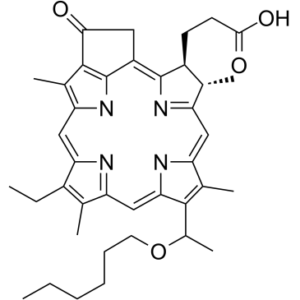Photochlor (HTTP)
This product is for research use only, not for human use. We do not sell to patients.

For small sizes, please check our retail website as below: www.invivochem.com
| Size | Price | Stock |
|---|---|---|
| 100mg | $1200 | Check With Us |
| 250mg | $2200 | Check With Us |
| 500mg | $3300 | Check With Us |
Cat #: V7963 CAS #: 149402-51-7 Purity ≥ 98%
Description: Photochlor (HTTP), a photodynamic therapy (PDT) agent, is a lipophilic, second-generation, chlorin-based photosensitizer.
Top Publications Citing Invivochem Products
Publications Citing InvivoChem Products
Product Promise

- Physicochemical and Storage Information
- Protocol
- Related Biological Data
- Stock Solution Preparation
- Quality Control Documentation
| Molecular Weight (MW) | 636.82 |
|---|---|
| Molecular Formula | C39H48N4O4 |
| CAS No. | 149402-51-7 |
| SMILES Code | O=C(O)CC[C@@H]([C@@H]/1C)C2=NC1=C/C3=C(C)C(C(OCCCCCC)C)=C(N3)/C=C4C(C)=C(CC)/C(N/4)=C/C5C(C)=C6C(N5)=C2CC6=O |
| Synonyms | HPPH; Photochlor; |
| Protocol | In Vitro | Fluorescence image of 4T1 cells incubated with 0.49 µg/mL GO-PEG, 1 μM HPPH (free HPPH) or equivalent amount of GO-PEG-HPPH (1 µM HPPH and 0.49 µg/mL GO-PEG) after 24 h. The cellular uptake of GO-PEG-HPPH and HPPH is investigated with 4T1 murine mammary cancer cells. The cells are incubated with GO-PEG-HPPH and free HPPH at equivalent HPPH concentration (1 µM) for 24 h and then observed with a confocal microscope. Cells treated with GO-PEG-HHPH shows stronger fluorescence signal than those treated with free HPPH. In fact, the fluorescence of HPPH is rather weak. |
|---|---|---|
| In Vivo | Tumors are treated with an immune-enhancing PDT regimen followed by a tumor-controlling PDT regimen can leads to enhancement of anti-tumor immunity, while retaining effective control of primary tumor growth. To test this hypothesis, a combination treatment regimen is devised in which Colo26-HA tumor-bearing BALB/c mice are treated with a HPPH-PDT regimen known to lead to enhanced anti-tumor immunity (0.4 μmoles/kg HPPH followed 18 h later by illumination with 665 nm light for a total dose of 48 J/cm2). Following illumination, mice are rested for 9 days; on the ninth day, mice are injected with HPPH. On day 10 following the first treatment, tumors are treated with a tumor control treatment regimen (illumination with 665 nm light for a total dose of 132 J/cm2 given). |
These protocols are for reference only. InvivoChem does not
independently validate these methods.
| Solvent volume to be added | Mass (the weight of a compound) | |||
|---|---|---|---|---|
| Mother liquor concentration | 1mg | 5mg | 10mg | 20mg |
| 1mM | 1.5703 mL | 7.8515 mL | 15.7030 mL | 31.4060 mL |
| 5mM | 0.3141 mL | 1.5703 mL | 3.1406 mL | 6.2812 mL |
| 10mM | 0.1570 mL | 0.7852 mL | 1.5703 mL | 3.1406 mL |
| 20mM | 0.0785 mL | 0.3926 mL | 0.7852 mL | 1.5703 mL |
| Quality Control Documentation |
|
|---|
The molarity calculator equation
Mass(g) = Concentration(mol/L) × Volume(L) × Molecular Weight(g/mol)
Mass
=
Concentration
×
Volume
×
Molecular Weight*
The dilution calculator equation
Concentration(start)
×
Volume(start)
=
Concentration(final)
×
Volume(final)
This equation is commonly abbreviated as: C1 V1 = C2 V2
Concentration(start)
C1
×
Volume(start)
V1
=
Concentration(final)
C2
×
Volume(final)
V2
Step One: Enter information below
Dosage mg/kg
Average weight of animals g
Dosing volume per animal µL
Number of animals
Step Two: Enter the in vivo formulation
%DMSO
+
%
+
%Tween 80
+
%ddH2O
Calculation Results:
Working concentration:
mg/ml;
Method for preparing DMSO master liquid:
mg
drug pre-dissolved in
µL
DMSO(Master liquid concentration
mg/mL)
,Please contact us first if the concentration exceeds the DMSO solubility of the batch of drug.
Method for preparing in vivo formulation:
Take
µL
DMSO master liquid, next add
µL
PEG300, mix and clarify, next add
µL
Tween 80,mix and clarify, next add
µL
ddH2O,mix and clarify.
Note:
- (1) Please be sure that the solution is clear before the addition of next solvent. Dissolution methods like vortex, ultrasound or warming and heat may be used to aid dissolving.
- (2) Be sure to add the solvent(s) in order.




































